There's no link-building without outreach.
Pretty much every single type of link-building campaign requires contacting websites and requesting links. I mean, you can wait for bloggers or website owners to find your content organically and link to it if they like the quality, but this takes months and has a limited reach.
The catch is that outreach is also the most challenging part of link building. Everybody and their dog is doing it—they have been for years—and most people don't bother to open the dozens of emails they receive every day.
Unless you get in touch with a link farm, of course, but that's not the kind of link you should be targeting.
In the article, we share tips on how to create link-building outreach emails that do get responses. More importantly, you will learn how to orchestrate comprehensive backlink outreach campaigns.
Before this, let's get a few basics out of the way.
What Is Link Building Outreach?
Link-building outreach is a process that involves identifying potential link partners and targeting them with personalized messages.
The objective?
Building genuine relationships that eventually bring high-quality backlinks.
Traditionally, email was the medium of choice for link builders. However, these days, social media platforms like LinkedIn or Twitter X and messengers like Slack, WhatsApp, or Telegram are very popular, and we've had a lot of success using them for outreach.
Building links requires outreach, no matter what tactic you use.
- In guest posting, you reach out to editors and pitch your article ideas.
- To secure link exchanges, you need to reach out to relevant website owners.
- You use outreach to let webmasters know about broken links and ask them to link to your content.
- You need outreach to turn unlinked mentions into linked ones.
- Digital PR relies on reaching out to journalists and pitching stories.
- Outreach is a key part of resource page link building.
- The skyscraper method uses outreach to promote the content you've created.
The list doesn't end. Even if your main strategy is creating linkable assets that could earn backlinks organically, the results will be limited if you don't promote them, especially if you haven't got an established following.
How to Do Link Building Outreach?
With the theory out of the way, here's our link outreach process.
Create valuable content
High-quality content is the foundation of all white-hat link-building efforts. Because why would anyone want to link back to or publish mediocre blogs or images?
To stand a chance, your content needs to add value by offering original insights or a unique perspective and satisfy the needs and wants of the audience.
If you don't know who your audience is or what they need, research it.
For example, if you're pitching a guest post idea, research the audience of the website and its existing content to identify gaps.
You can do it in Ahrefs by using the Competitive Analysis tool.
First, enter your target's domain URL and those of your competitors. Hit the Show Keyword Opportunities button.
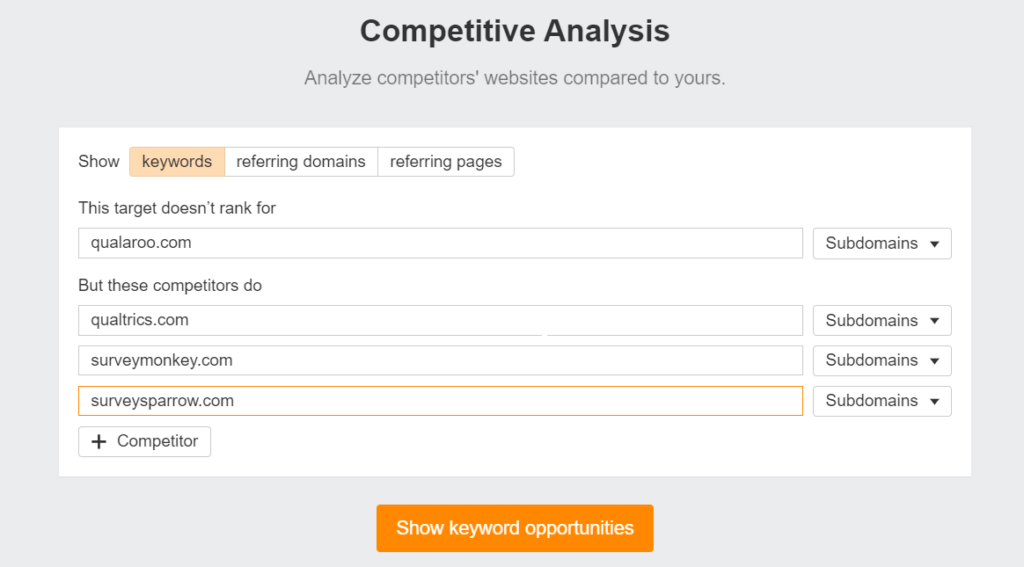
If you don't know their organic competitors, you can find them in the Site Explorer.
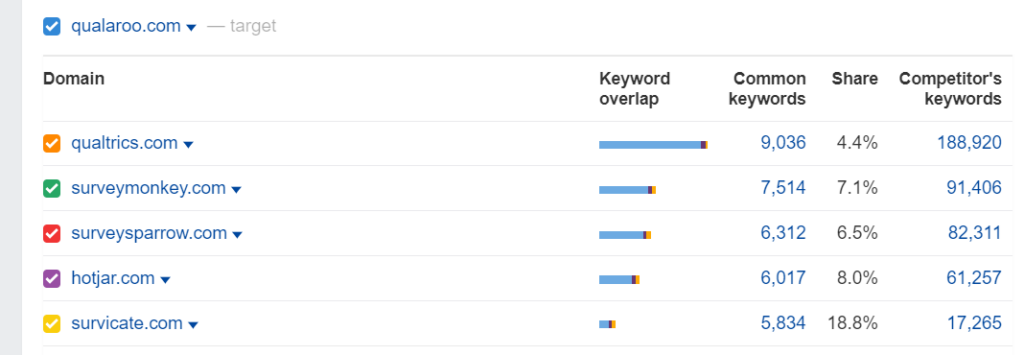
Next, filter the keywords to include those that all competitors rank for in the top 10 and the target website doesn't.
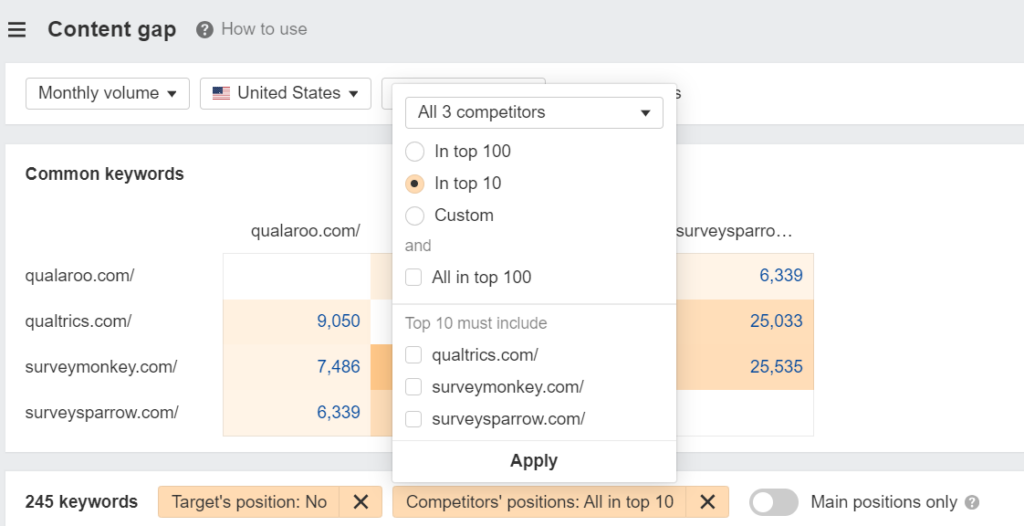
After that, use Keyword Difficulty (0-30) and Search volume filters (300+) to further narrow down the choices. That's how we go down from 245 keywords to 7.
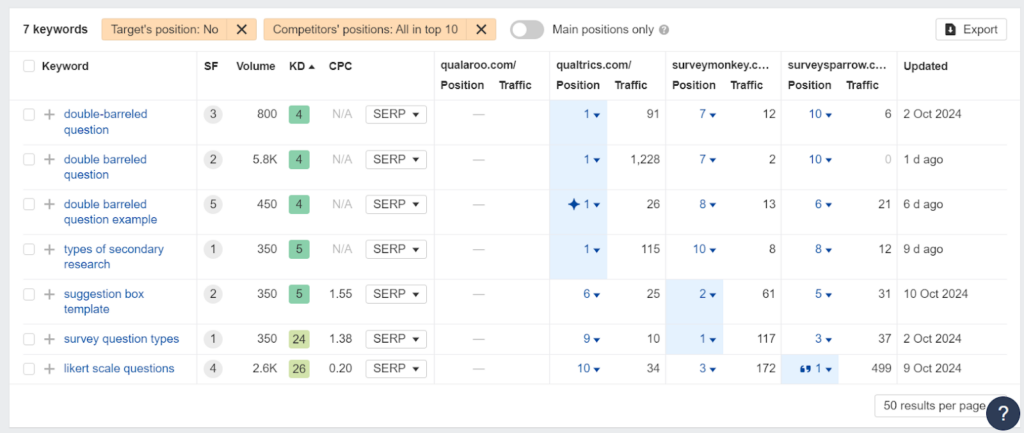
These include "types of secondary research" and "survey question types," both being possible topics for an article.
The fact that the prospect doesn't rank for the keyword doesn't mean they don't have content on it, so search their blog for the keyword.
If you're researching linkable content ideas for your website, analyze your competitors' websites for pages with the highest backlink count. You can find them in Ahrefs Site Explorer (Best by links report).
You can see that two pieces of content have been particularly effective for one of our competitors: a link-building stat round-up and a state of link-building report. Journalists and writers love this kind of content because it makes their research easier and helps them increase their credibility. So, a logical thing would be to create such an article.
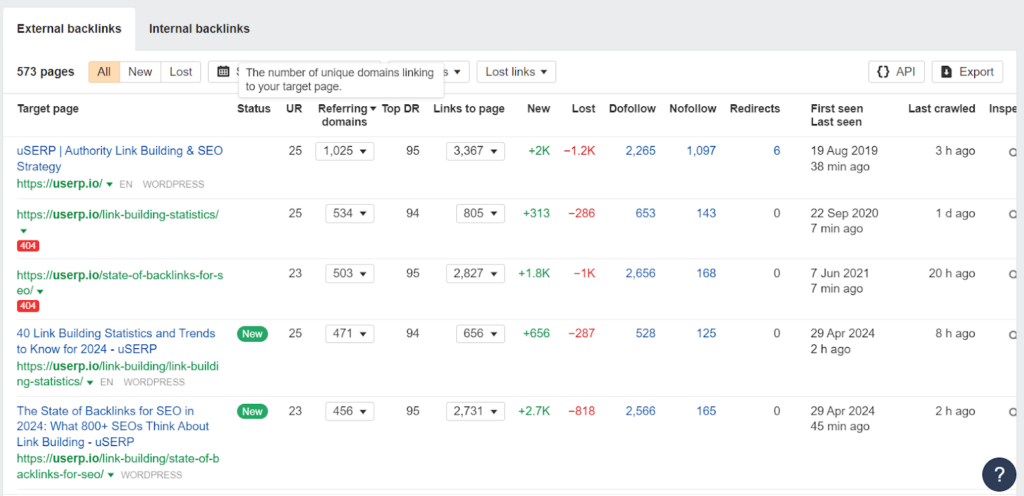
We did! And it worked a treat: our State of Link-building 2024 report has over 100 links from 58 unique websites. Some of these are organic, but a few come from link-building outreach.
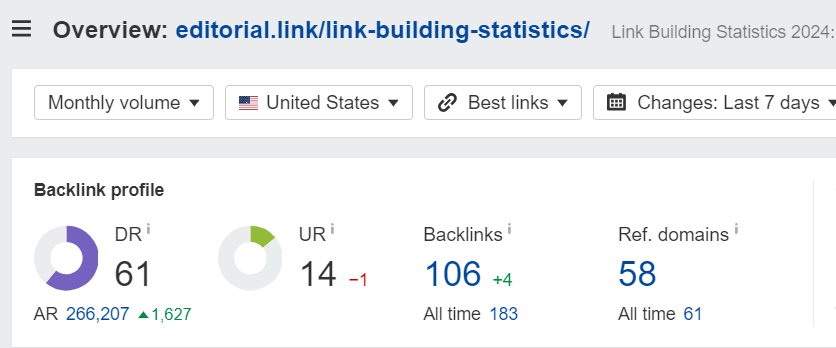
What other content attracts links?
- Comprehensive guides that give the reader all the information they need on the topic, especially actionable advice.
- Infographics that help readers understand complex ideas and make content visually appealing.
- Expert roundups, interviews, and thought leadership content that provides unique insights.
- Case studies demonstrating real-life application of tools or processes and evidence of their effectiveness.
- Newsworthy and controversial content that stimulates public discussion on the topic.
Find the right outreach targets
The effectiveness of your outreach efforts depends on how well you can identify the right link prospects.
Let's look for them, starting with guest posting opportunities.
Google is your best friend here: Search for your niche and one of the operators below, for example, SEO "Write for us".
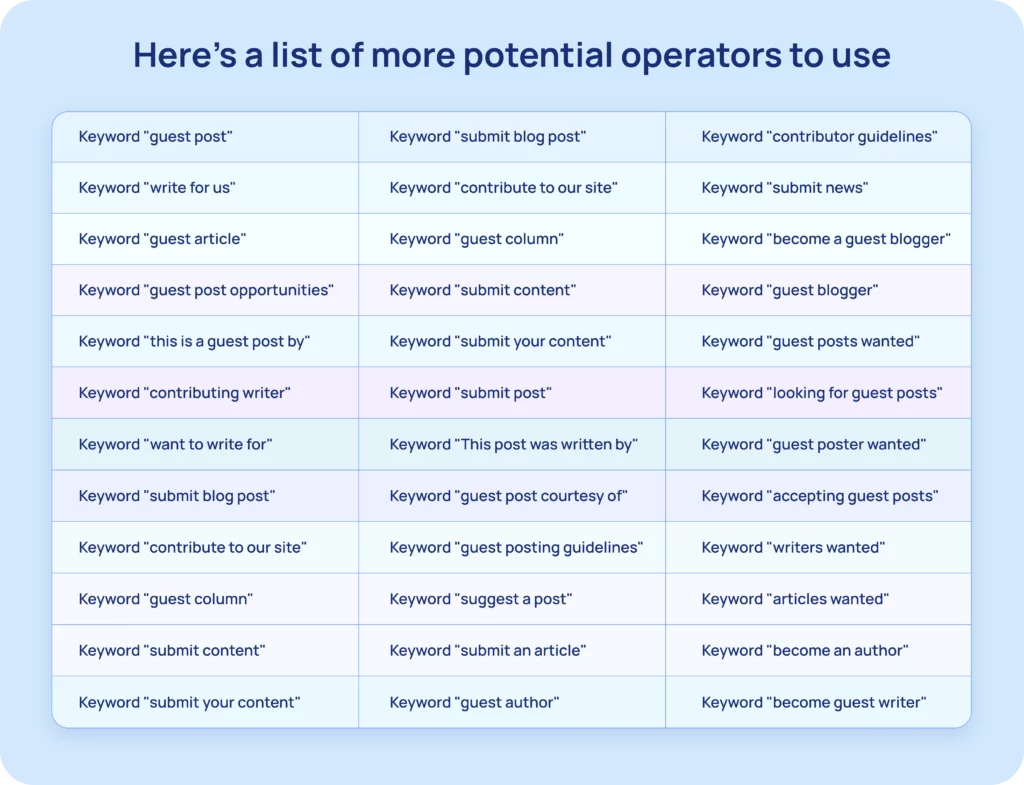
Competitor analysis, which I showed you above, is another way: if the websites link to your competitors, they might link to you. And if not them, you can figure out what kind of website might be interested in your content.
Let's imagine we want to build more links to our report with link-building stats.
In the Best by links report, click on the number of referring domains next to the article to expand the list and then Open in a new tab in the top right corner.
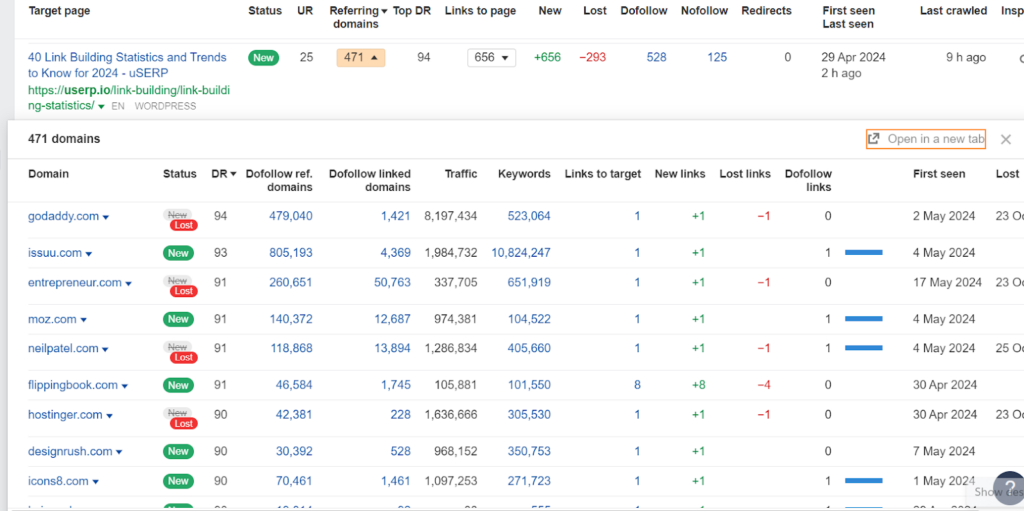
Next, filter the results by DR (40+), traffic (1000+), and rel=tag (dofollow) to narrow down choices.

Export the list into a spreadsheet and manually check each of them for relevance.
This, in my opinion, is the key factor to consider when vetting prospects. A link from a website with an excellent backlink profile won't always improve your search engine rankings if it isn't relevant. What's worse, irrelevant links, or even irrelevant anchor texts, can confuse bots about your website content.
A manual check will also help you eliminate link farms from the list. You can also use our free Link Type Classifier to determine if a website sells links.
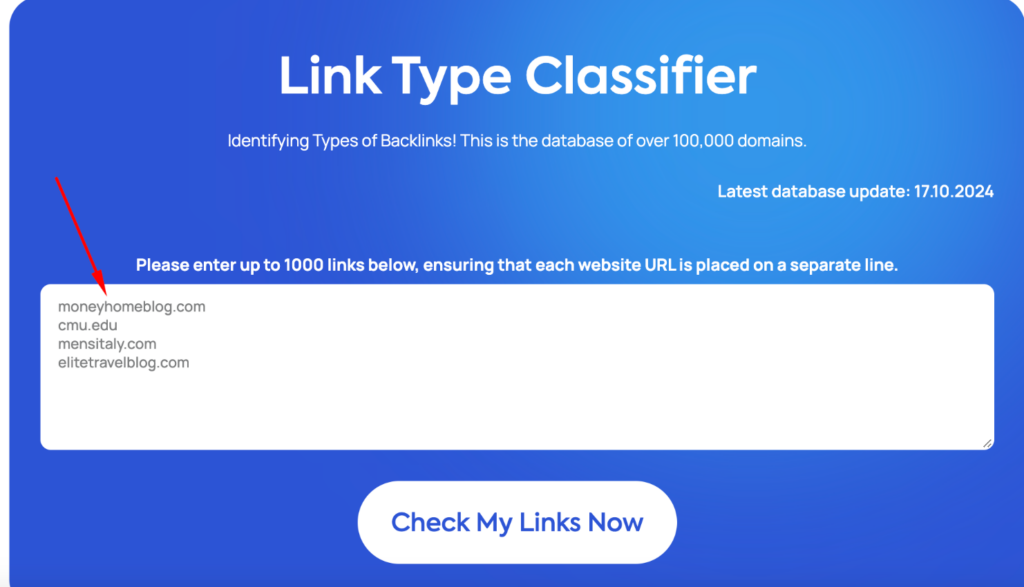
The vetting process is the same regardless of the link-building technique you use.
A tool like Ahrefs can help you find broken links on potential target pages, unlinked brand mentions, or listicles featuring your competitors but not you.
Find contact details
Once you have your outreach list, look for their contact details.
Lots of SEOs, myself included, use Hunter.io to find the names and email addresses of the people they contact in their link-building campaigns.
Here's a quick guide on how to do it:
1. Navigate to Bulks and choose Domain Search.
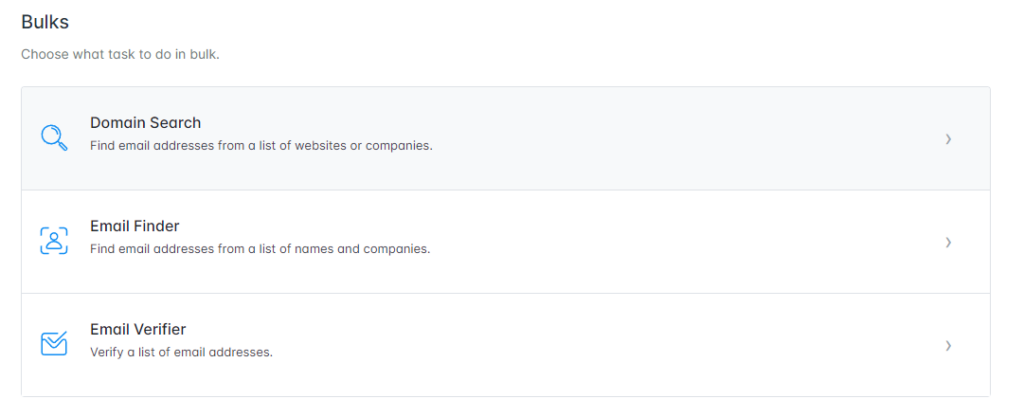
2. Create a new Bulk. Either copy/paste the list of domains you're interested in or upload it as a CSV, Excel, or TXT file.
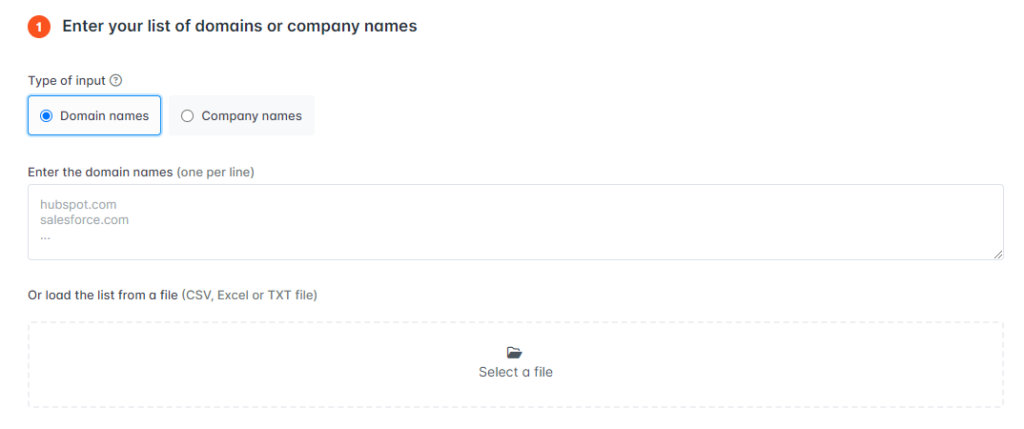
3. Set the filters to Marketing and Writing & Communication to narrow down the search focus. Jenny from Accounts is a top girl but might not be able to help you get that link placement.
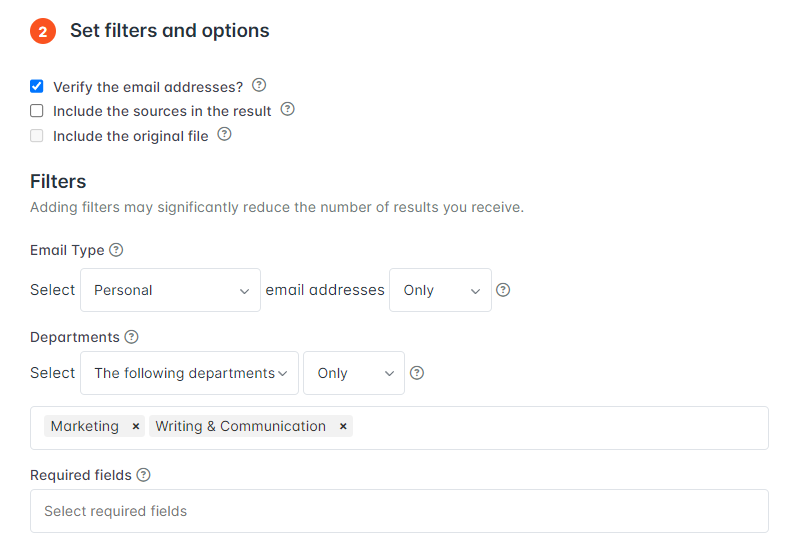
Hunter.io allows you to search for the email addresses of specific people if you know their names. You can do it individually or in bulk.

How can you learn the names of the editors, heads of marketing, or SEOs with the power to give you the link?
User social media, like LinkedIn.
Harness social media
As mentioned, link-building outreach isn't just an email game anymore. More and more outreach experts use social media platforms to secure link placements for their businesses.
The main reason is that such platforms allow you to build relationships with the people in your sector.
By commenting on their content, you gradually establish a connection. This warms up the otherwise cold outreach and makes it more personal. When you contact them with a collaboration idea, they're more likely to respond because you aren't some anonymous spammer but a person they trust. Or at least, recognize.
Your social media presence is also an opportunity to showcase what you stand for and establish yourself as an authority in your niche. This increases your credibility as a link-building partner. If you play the game well, people will start reaching out to you, not vice versa.
Finally, if you choose to boycott social media, you might miss opportunities to get high-quality links like this one from Backlinko. To get a chance to write a guest post for them, you need to follow Leigh McKenzie.
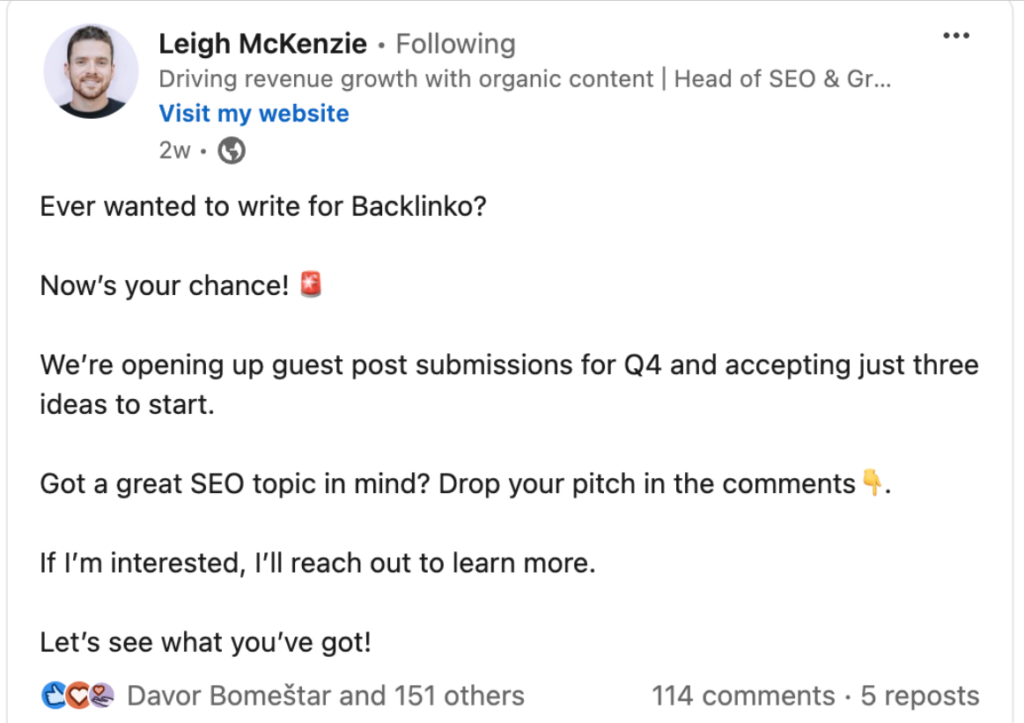
Create your outreach messages
Check out this email template.
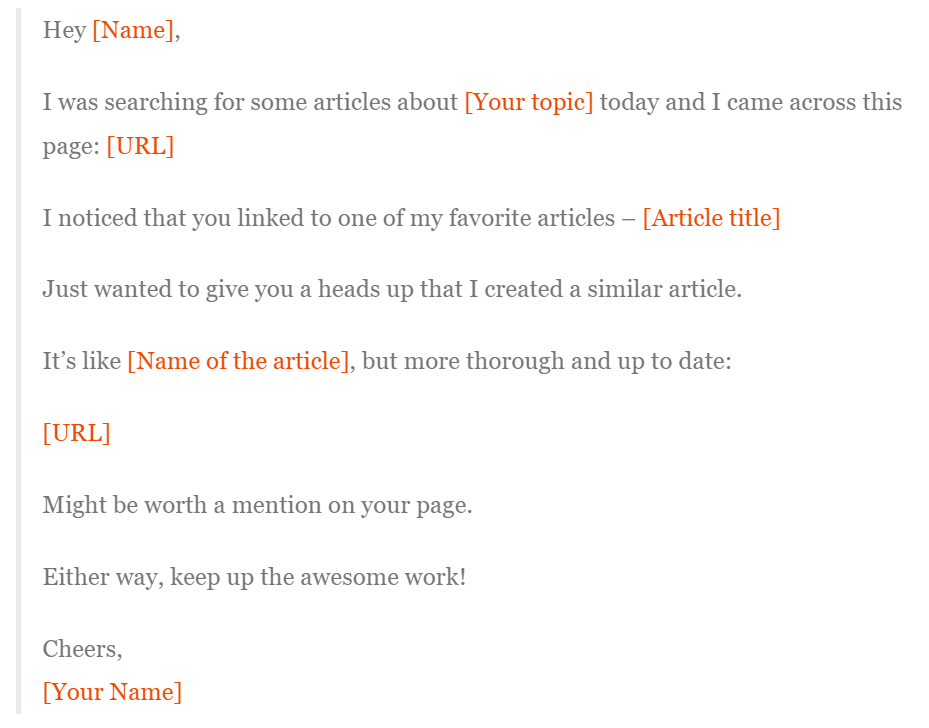
Looks familiar?
I bet.
This is the template Brian Dean used for his skyscraper technique outreach. If you've been in the SEO space for a while, you must have seen it. If you run an active website, you may have even received one.
And that's the thing:
The template has been around for years—overused and abused—and it doesn't work anymore. The bar is much higher these days!
The email below, borrowed from Roni Shehu's presentation, is way better:
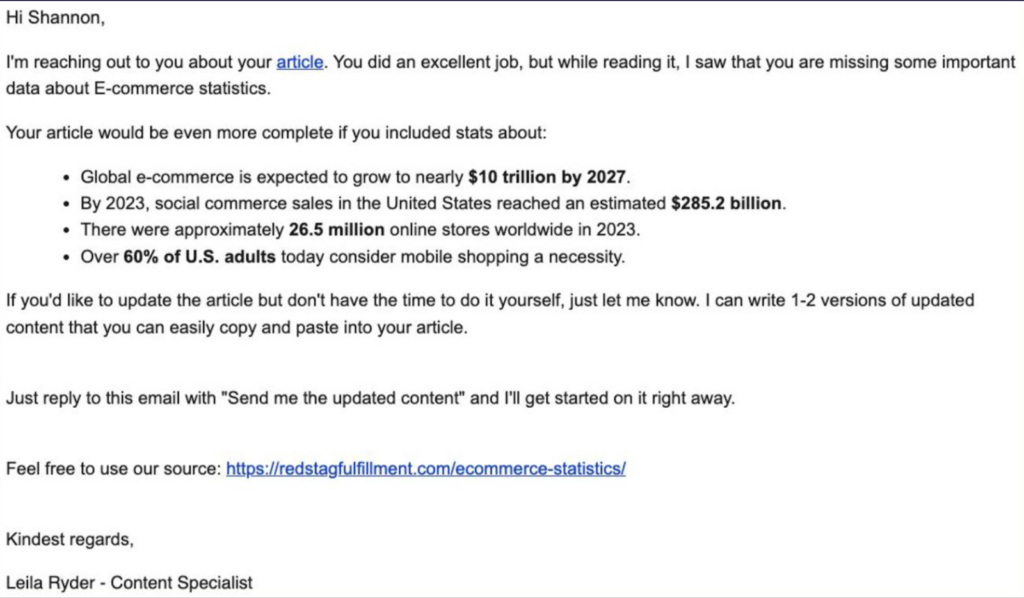
What makes it so good?
- Personalization: addresses a specific person and identifies content gaps in their content.
- Clear value offer with no strings attached: it gives the recipient a way to improve their content without asking for anything in return.
- Minimum friction: accepting the offer doesn’t require any effort.
- Clear layout: Bullet points, short paragraphs (1-2 sentences), and white space make it easier to understand.
- Clickable links: They make finding the content easy.
- Conciseness: Don’t go over 150 words.
In addition to the email content, its subject line matters a lot:
- The optimal subject line length is 30-50 characters or 4-7 words.
- Subject lines that include numbers have 45% higher open rates.
- Questions in subject lines can increase open rates by up to 10%.
Bearing outreach best practices in mind, here are a few more outreach templates for different B2B link-building tactics.
Unlinked brand mentions

Broken link-building
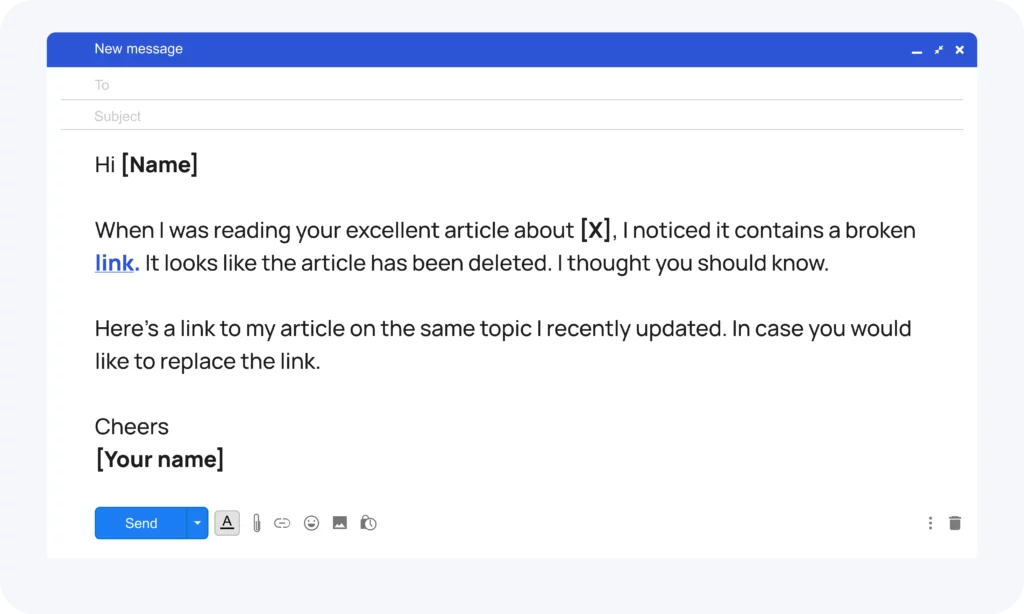
Listicle link-building
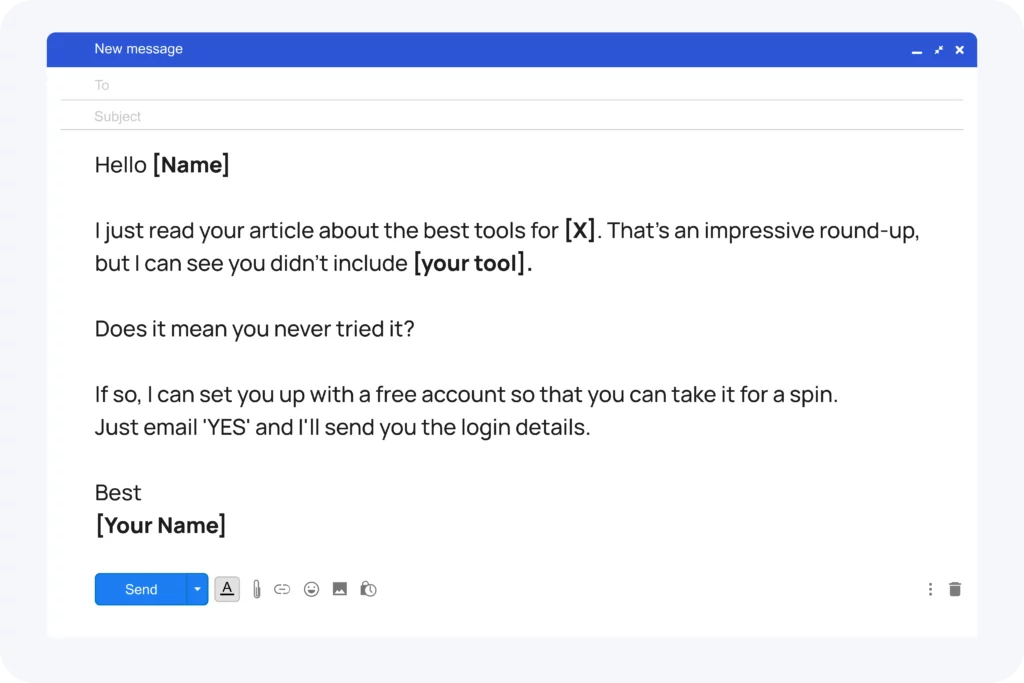
Guest posting

Schedule the email
When you send the email is as important for open and response rates as the subject line or its content.
CoSchedule has recently reviewed ten studies on the best days and times to send outreach emails to maximize open rates.
Their conclusions?
- Thursdays, Tuesdays, and Wednesdays are the top 3 days to send emails (in this order). Followed by Monday, Friday and the weekend. Our experience shows that Fridays are indeed the worst workdays for outreach, probably because lots of folks either don't work on Fridays at all or "zone out" early for the weekend.
- 10 am is the best time, followed by 9 and 8 am. Then after lunch, at 1 and 3 pm. Between 7 pm and 2 am is the worst time. Just remember to adjust these to the time zone of your target audiences
Don’t forget to follow up
Let's face it: email outreach is a numbers game, and sending one message isn't usually enough. In fact, only 8.5% of outreach emails get a response.
So, always schedule a follow-up email.
Just one follow-up email can increase the response rate by 65%, Woodpecker data shows. According to Hunter, a sequence of 3 follow-up emails is the most effective. After that, their impact diminishes.
I mean, if you send more follow-ups, your success rate will go up, but the results may not justify the increasing effort. You can't simply send the same email again and again. Each needs to be unique and build upon the previous one.
And there's a risk that your email address will end up in the spam list if people find your emails too intrusive.
How quickly should you follow up?
Definitely not the next day. This can decrease the response rate by 11%, Belkins has found. According to their research, it's best to wait 2-5 days before you follow up.
Here's an example of a follow-up email to a guest post request.
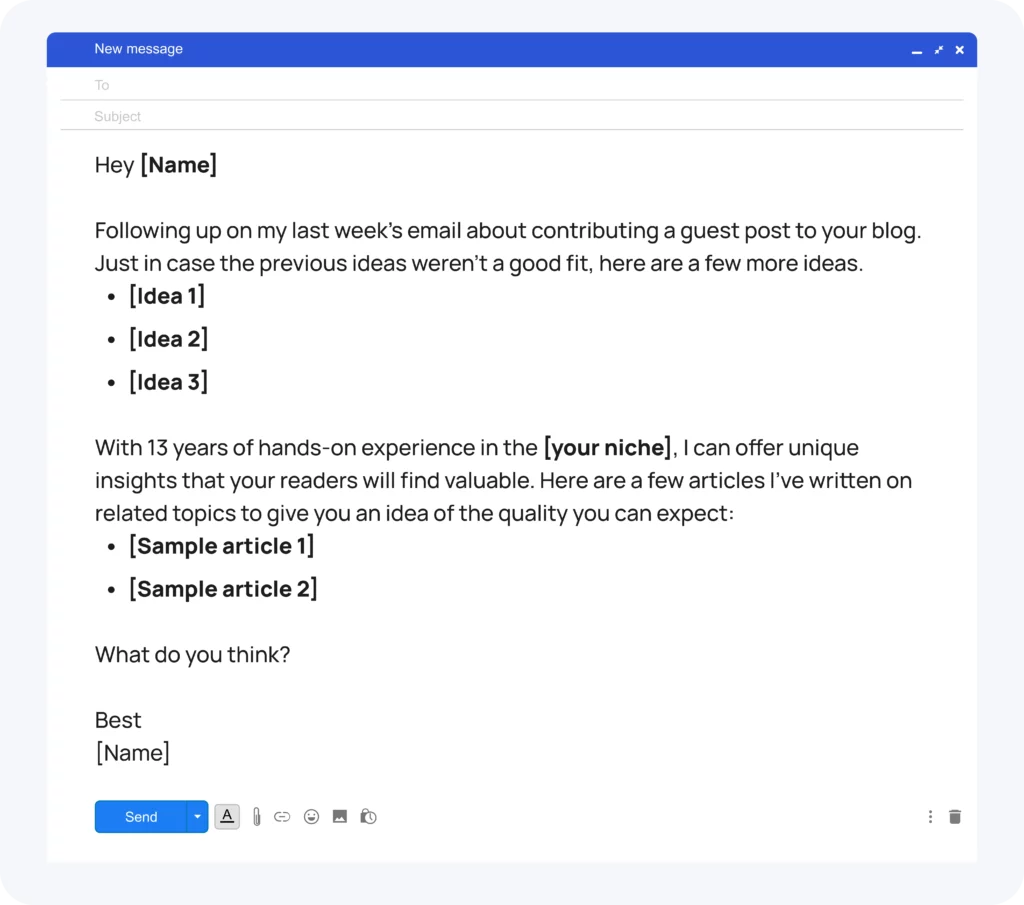
Handle rejections
Even if you get a response to your email, it isn't always what you'd like to see. Rejections are common, and handling them is a part of the game.
Here are a few possible scenarios:
- The website's backlink policy doesn't allow any external links.
- The webmaster refuses to provide the link for free.
- They insist on monetary compensation.
- Your website metrics are not up to their standards, and as a result, a link exchange is a no-go.
- The website owner doesn't do link insertions in old content.
Here’s an example of a message for the last scenario:
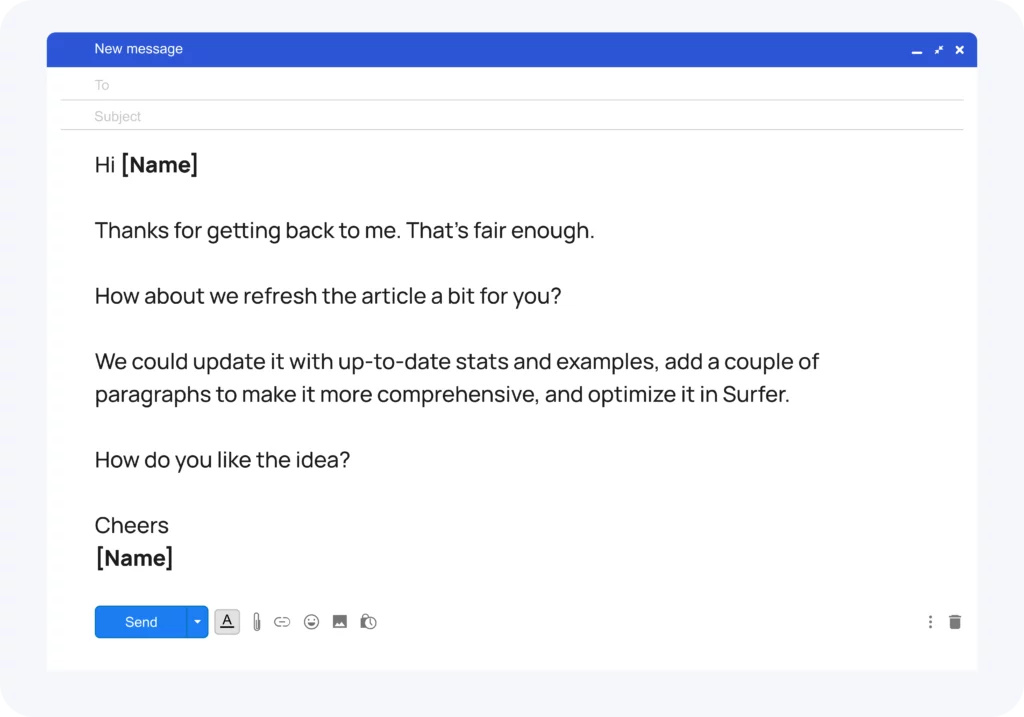
Track the result
Tracking your outreach results is essential for a few reasons.
First of all, it allows you to measure the effectiveness of your outreach campaigns and their impact on your SEO strategy. Are you building enough links? Are they the right kind of link? Are the links moving the needle in the right direction?
Moreover, tracking your results allows you to avoid work duplication and ensure that you follow up at the right time.
Finally, tracking your success rates allows you to refine your tactics and strategies.
For example, you can use the insights to tweak your templates or adjust the timing of your emails.
You can track the performance of your link outreach campaign using an outreach platform like Pitchbox and Respona.
Such tools can help you streamline processes, but they don’t always allow you to customize your workflows and reports. That’s why we prefer using a spreadsheet.
Here’s what it looks like on a high level.
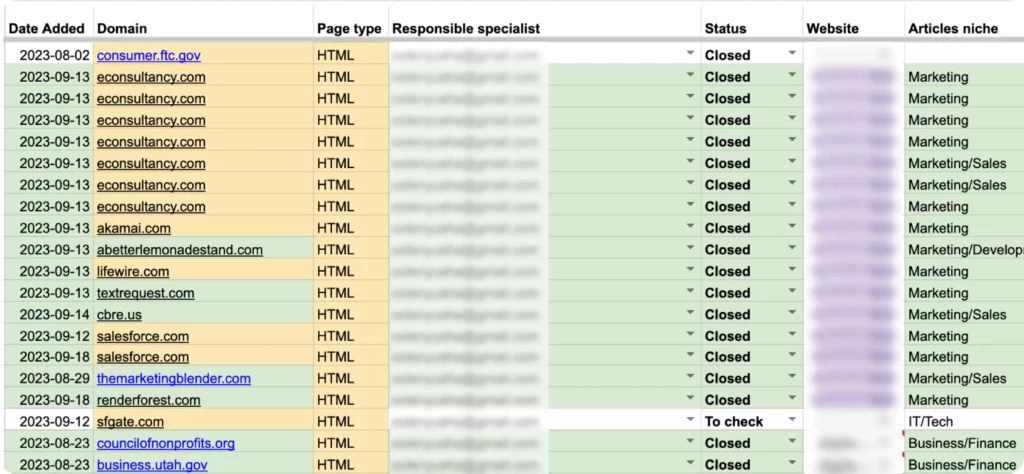
We also track details like the lead name, position, company, the last date you contacted them and how many times, and which templates you used each time.
Wrapping Up
Link-building and outreach go together. Whether you're guest posting, doing digital PR, or promoting your content, you need to find people who can help and share what you have to offer.
Traditionally, link-building outreach was about asking them to link to you. Now, it's more about building and cultivating long-term relationships.
This takes time and a lot of energy on top of everything else that you're doing for your work. Not every organization has the bandwidth to do so. In their situation, outsourcing the link-building to an agency is an attractive alternative.
Such agencies do relationship-building for a living and can leverage their partner networks to help you with link acquisition.
Sounds like what you need?
Get in touch with the Editorial.Link team.

